Yitong Pang
Data-Augmented Counterfactual Learning for Bundle Recommendation
Oct 19, 2022



Abstract:Bundle Recommendation (BR) aims at recommending bundled items on online content or e-commerce platform, such as song lists on a music platform or book lists on a reading website. Several graph based models have achieved state-of-the-art performance on BR task. But their performance is still sub-optimal, since the data sparsity problem tends to be more severe in real bundle recommendation scenarios, which limits graph-based models from more sufficient learning. In this paper, we propose a novel graph learning paradigm called Counterfactual Learning for Bundle Recommendation (CLBR) to mitigate the impact of data sparsity problem and improve bundle recommendation. Our paradigm consists of two main parts: counterfactual data augmentation and counterfactual constraint. The main idea of our paradigm lies in answering the counterfactual questions: "What would a user interact with if his/her interaction history changes?" "What would a user interact with if the bundle-item affiliation relations change?" In counterfactual data augmentation, we design a heuristic sampler to generate counterfactual graph views for graph-based models, which has better noise controlling than the stochastic sampler. We further propose counterfactual loss to constrain model learning for mitigating the effects of residual noise in augmented data and achieving more sufficient model optimization. Further theoretical analysis demonstrates the rationality of our design. Extensive experiments of BR models applied with our paradigm on two real-world datasets are conducted to verify the effectiveness of the paradigm
Intention Adaptive Graph Neural Network for Category-aware Session-based Recommendation
Dec 31, 2021



Abstract:Session-based recommendation (SBR) is proposed to recommend items within short sessions given that user profiles are invisible in various scenarios nowadays, such as e-commerce and short video recommendation. There is a common scenario that user specifies a target category of items as a global filter, however previous SBR settings mainly consider the item sequence and overlook the rich target category information in this scenario. Therefore, we define a new task called Category-aware Session-Based Recommendation (CSBR), focusing on the above scenario, in which the user-specified category can be efficiently utilized by the recommendation system. To address the challenges of the proposed task, we develop a novel method called Intention Adaptive Graph Neural Network (IAGNN), which takes advantage of relationship between items and their categories to achieve an accurate recommendation result. Specifically, we construct a category-aware graph with both item and category nodes to represent the complex transition information in the session. An intention-adaptive graph neural network on the category-aware graph is utilized to capture user intention by transferring the historical interaction information to the user-specified category domain. Extensive experiments on three real-world datasets are conducted to show our IAGNN outperforms the state-of-the-art baselines in the new task.
Temporal aware Multi-Interest Graph Neural Network For Session-based Recommendation
Dec 31, 2021



Abstract:Session-based recommendation (SBR) is a challenging task, which aims at recommending next items based on anonymous interaction sequences. Despite the superior performance of existing methods for SBR, there are still several limitations: (i) Almost all existing works concentrate on single interest extraction and fail to disentangle multiple interests of user, which easily results in suboptimal representations for SBR. (ii) Furthermore, previous methods also ignore the multi-form temporal information, which is significant signal to obtain current intention for SBR. To address the limitations mentioned above, we propose a novel method, called \emph{Temporal aware Multi-Interest Graph Neural Network} (TMI-GNN) to disentangle multi-interest and yield refined intention representations with the injection of two level temporal information. Specifically, by appending multiple interest nodes, we construct a multi-interest graph for current session, and adopt the GNNs to model the item-item relation to capture adjacent item transitions, item-interest relation to disentangle the multi-interests, and interest-item relation to refine the item representation. Meanwhile, we incorporate item-level time interval signals to guide the item information propagation, and interest-level time distribution information to assist the scattering of interest information. Experiments on three benchmark datasets demonstrate that TMI-GNN outperforms other state-of-the-art methods consistently.
Multi-Choice Questions based Multi-Interest Policy Learning for Conversational Recommendation
Dec 22, 2021



Abstract:Conversational recommendation system (CRS) is able to obtain fine-grained and dynamic user preferences based on interactive dialogue. Previous CRS assumes that the user has a clear target item. However, for many users who resort to CRS, they might not have a clear idea about what they really like. Specifically, the user may have a clear single preference for some attribute types (e.g. color) of items, while for other attribute types, the user may have multiple preferences or even no clear preferences, which leads to multiple acceptable attribute instances (e.g. black and red) of one attribute type. Therefore, the users could show their preferences over items under multiple combinations of attribute instances rather than a single item with unique combination of all attribute instances. As a result, we first propose a more realistic CRS learning setting, namely Multi-Interest Multi-round Conversational Recommendation, where users may have multiple interests in attribute instance combinations and accept multiple items with partially overlapped combinations of attribute instances. To effectively cope with the new CRS learning setting, in this paper, we propose a novel learning framework namely, Multi-Choice questions based Multi-Interest Policy Learning . In order to obtain user preferences more efficiently, the agent generates multi-choice questions rather than binary yes/no ones on specific attribute instance. Besides, we propose a union set strategy to select candidate items instead of existing intersection set strategy in order to overcome over-filtering items during the conversation. Finally, we design a Multi-Interest Policy Learning module, which utilizes captured multiple interests of the user to decide next action, either asking attribute instances or recommending items. Extensive experimental results on four datasets verify the superiority of our method for the proposed setting.
Multi-behavior Graph Contextual Aware Network for Session-based Recommendation
Sep 24, 2021



Abstract:Predicting the next interaction of a short-term sequence is a challenging task in session-based recommendation (SBR).Multi-behavior session recommendation considers session sequence with multiple interaction types, such as click and purchase, to capture more effective user intention representation sufficiently.Despite the superior performance of existing multi-behavior based methods for SBR, there are still several severe limitations:(i) Almost all existing works concentrate on single target type of next behavior and fail to model multiplex behavior sessions uniformly.(ii) Previous methods also ignore the semantic relations between various next behavior and historical behavior sequence, which are significant signals to obtain current latent intention for SBR.(iii) The global cross-session item-item graph established by some existing models may incorporate semantics and context level noise for multi-behavior session-based recommendation. To overcome the limitations (i) and (ii), we propose two novel tasks for SBR, which require the incorporation of both historical behaviors and next behaviors into unified multi-behavior recommendation modeling. To this end, we design a Multi-behavior Graph Contextual Aware Network (MGCNet) for multi-behavior session-based recommendation for the two proposed tasks. Specifically, we build a multi-behavior global item transition graph based on all sessions involving all interaction types. Based on the global graph, MGCNet attaches the global interest representation to final item representation based on local contextual intention to address the limitation (iii). In the end, we utilize the next behavior information explicitly to guide the learning of general interest and current intention for SBR. Experiments on three public benchmark datasets show that MGCNet can outperform state-of-the-art models for multi-behavior session-based recommendation.
Graph Learning Augmented Heterogeneous Graph Neural Network for Social Recommendation
Sep 24, 2021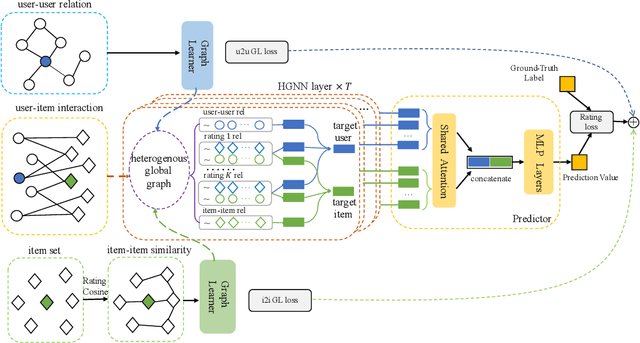
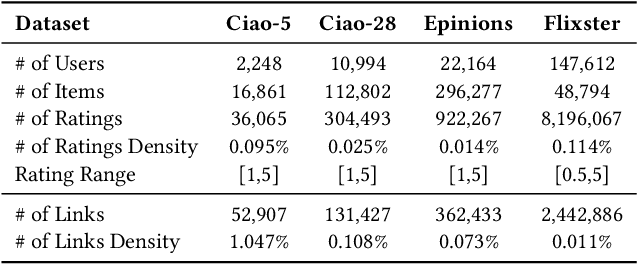
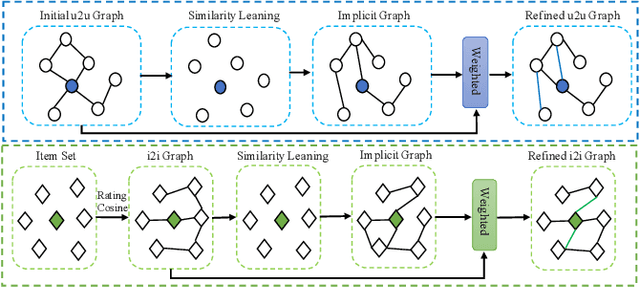
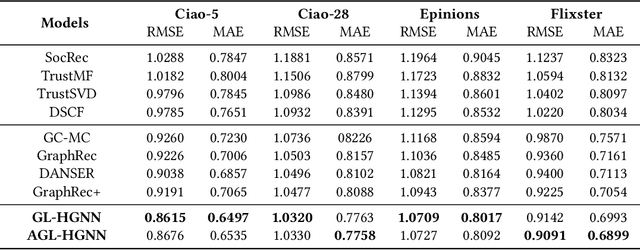
Abstract:Social recommendation based on social network has achieved great success in improving the performance of recommendation system. Since social network (user-user relations) and user-item interactions are both naturally represented as graph-structured data, Graph Neural Networks (GNNs) have thus been widely applied for social recommendation. In this work, we propose an end-to-end heterogeneous global graph learning framework, namely Graph Learning Augmented Heterogeneous Graph Neural Network (GL-HGNN) for social recommendation. GL-HGNN aims to learn a heterogeneous global graph that makes full use of user-user relations, user-item interactions and item-item similarities in a unified perspective. To this end, we design a Graph Learner (GL) method to learn and optimize user-user and item-item connections separately. Moreover, we employ a Heterogeneous Graph Neural Network (HGNN) to capture the high-order complex semantic relations from our learned heterogeneous global graph. To scale up the computation of graph learning, we further present the Anchor-based Graph Learner (AGL) to reduce computational complexity. Extensive experiments on four real-world datasets demonstrate the effectiveness of our model.
Heterogeneous Global Graph Neural Networks for Personalized Session-based Recommendation
Jul 08, 2021
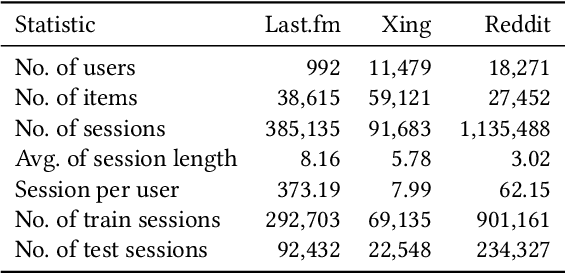


Abstract:Predicting the next interaction of a short-term interaction session is a challenging task in session-based recommendation. Almost all existing works rely on item transition patterns, and neglect the impact of user historical sessions while modeling user preference, which often leads to non-personalized recommendation. Additionally, existing personalized session-based recommenders capture user preference only based on the sessions of the current user, but ignore the useful item-transition patterns from other user's historical sessions. To address these issues, we propose a novel Heterogeneous Global Graph Neural Networks (HG-GNN) to exploit the item transitions over all sessions in a subtle manner for better inferring user preference from the current and historical sessions. To effectively exploit the item transitions over all sessions from users, we propose a novel heterogeneous global graph that contains item transitions of sessions, user-item interactions and global co-occurrence items. Moreover, to capture user preference from sessions comprehensively, we propose to learn two levels of user representations from the global graph via two graph augmented preference encoders. Specifically, we design a novel heterogeneous graph neural network (HGNN) on the heterogeneous global graph to learn the long-term user preference and item representations with rich semantics. Based on the HGNN, we propose the Current Preference Encoder and the Historical Preference Encoder to capture the different levels of user preference from the current and historical sessions, respectively. To achieve personalized recommendation, we integrate the representations of the user current preference and historical interests to generate the final user preference representation. Extensive experimental results on three real-world datasets show that our model outperforms other state-of-the-art methods.
 Add to Chrome
Add to Chrome Add to Firefox
Add to Firefox Add to Edge
Add to Edge